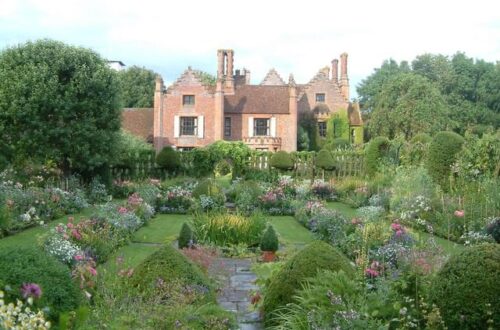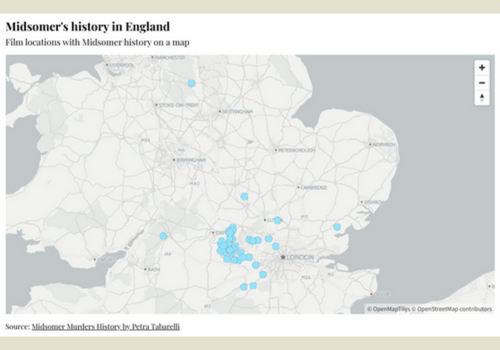
Ultimative Map of Midsomer County – History Edition
What if… Midsomer County was where it was shot and filmed? What if there was a map of Midsomer County showing the historical events? As if they were one with the film location?
You may already know me: because there was no such map of Midsomer, I made one myself. Ta-daaaa!
How did I do it?
I don’t have the software or the knowledge to create such a map myself, preferably using open source tools. I use flourish, a website where you enter data into a database made up of cells and named columns, similar to Excel. And which then automatically creates beautiful visualisations. In this case, this map of Midsomer County.
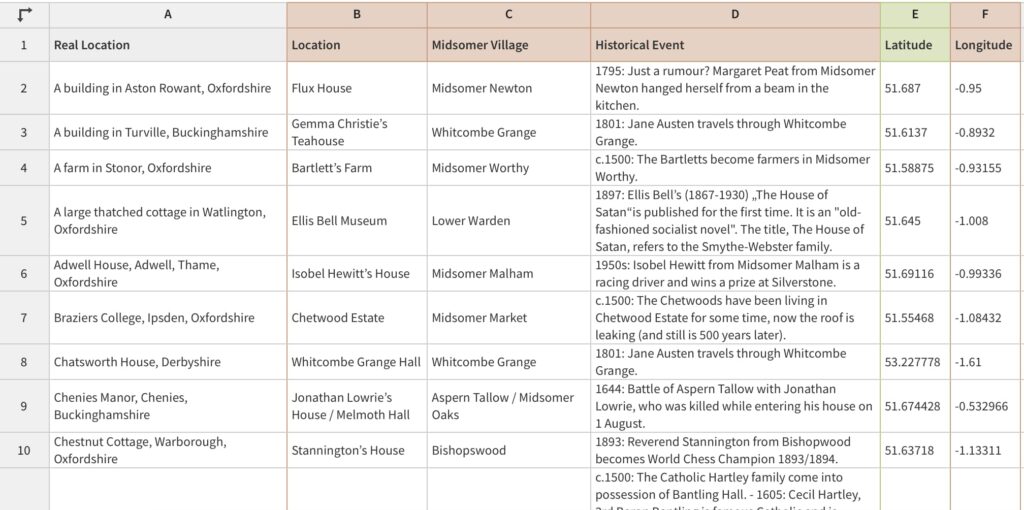
The first four columns contain the information that is displayed on mouse-over: The actual name of the location (usually a manor house), then the name in Midsomer Murders as well as the village, and finally the centrepiece: the historical event that took place here in Midsomer’s history. The latitude and longitude are also given so that the point is in the right place.
I added the information about the Midsomer villages later. It is actually irrelevant to the map of Midsomer, but I just wanted to show how fragmented a Midsomer village is in reality in the counties west of London.
Difficulties and how I solved them
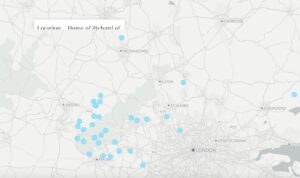 Were the number of columns too many for the visualisation? In some cases “only” the full text of the historical event was displayed, in others the display simply stopped after one or two columns (although further information followed in columns 3 and 4). The problem occurred in both Safari and Chrome.
Were the number of columns too many for the visualisation? In some cases “only” the full text of the historical event was displayed, in others the display simply stopped after one or two columns (although further information followed in columns 3 and 4). The problem occurred in both Safari and Chrome.
So I duplicated the project in Flourish (just in case) and deleted the Midsomer villages entry. And tested it again. The problem still occurred.
| 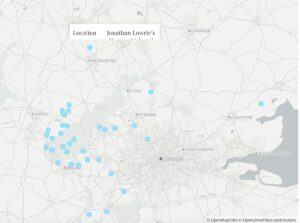
My next thought was that it might be the length of the historical event. I had only used the few words from the chronology, but some locations were not only used several times in Midsomer Murders, but also several times in Midsomer history.
So I quickly copied the database into Excel to have it in its entirety, and renamed the “Location” column in Flourish to “Midsomer Location” for clarification. And then I started to drastically shorten the text in the historical events column. After the first five lines, I checked my thesis – no change.
While troubleshooting and experimenting with the display settings, I noticed “pop-up”. Yes, of course I want a pop-up. But if it causes problems that I find difficult to solve, then an alternative might not be so bad.
So, instead of a pop-up, the image above has an overlay that opens on the left when you click on a point. This again includes the (full) text for the historical event, which I have also added to the first five entries in the database.
Here on this website, film locations of Midsomer Murders related to Midsomer history are presented one by one. Here you can find the overview. Already been published are articles about UCL Observatory in Midsomer Stanton and Chenies Manor House, Bucks, in Midsomer Murders (as of 24 April 2024). If you are generally interested in film locations – with and without history – then Joan Street’s website is just right for you.
Alternative to the map of Midsomer County
You don’t like working with the map or it doesn’t work for you for some reason?
Please let me know by email if there is a problem.
And just in case, you can find the data in tabular form here.
| Real Location | Midsomer Location | Historical Event |
| A building in Aston Rowant, Oxfordshire | Flux House | 1795: Just a rumour? Margaret Peat from Midsomer Newton hanged herself from a beam in the kitchen. |
| A building in Turville, Buckinghamshire | Gemma Christie’s Teahouse | 1801: Jane Austen travels through Whitcombe Grange. |
| A farm in Stonor, Oxfordshire | Bartlett’s Farm | c.1500: The Bartletts become farmers in Midsomer Worthy. |
| A large thatched cottage in Watlington, Oxfordshire | Ellis Bell Museum | 1897: Ellis Bell’s (1867-1930) „The House of Satan“is published for the first time. It is an “old-fashioned socialist novel”. The title, The House of Satan, refers to the Smythe-Webster family. |
| Adwell House, Adwell, Thame, Oxfordshire | Isobel Hewitt’s House | 1950s: Isobel Hewitt from Midsomer Malham is a racing driver and wins a prize at Silverstone. |
| Braziers College, Ipsden, Oxfordshire | Chetwood Estate | c.1500: The Chetwoods have been living in Chetwood Estate for some time, now the roof is leaking (and still is 500 years later). |
| Chatsworth House, Derbyshire | Whitcombe Grange Hall | 1801: Jane Austen travels through Whitcombe Grange. |
| Chenies Manor, Chenies, Buckinghamshire | Jonathan Lowrie’s House / Melmoth Hall | 1644: Battle of Aspern Tallow with Jonathan Lowrie, who was killed while entering his house on 1 August. |
| Chestnut Cottage, Warborough, Oxfordshire | Stannington’s House | 1893: Reverend Stannington from Bishopwood becomes World Chess Champion 1893/1894. |
| Dorney Court, Dorney, Buckinghamshire | Bantling Hall / Allenby House | c.1500: The Catholic Hartley family come into possession of Bantling Hall. – 1605: Cecil Hartley, 3rd Baron Bantling is famous Catholic and is involved in the Gunpowder Plot. – 1644: George, 4th Baron Bantling betrays the King at the Battle of Marston Moor. – 1775/1783: Thomas, 4th Baron of Bantling fights for the English colonies in America. |
| Fair Mile Hospital, Cholsey, Oxfordshire | St Fidelis | 1875: On 25 June, twenty-year-old Carolina Maria Roberts, suffering from tuberculosis, commits suicide by throwing herself from the staircase at St. Fidelis Hospital in March Magna. |
| Foxwarren Park, Wisley, Surrey | Smythe-Websters’ estate | 1867: Ellis Bell (“The House of Satan”) is born out of wedlock in Lower Warden. His mother worked in the big house in Upper Warden and was seduced by the son of the house. The Smythe-Websters denied paternity but helped young Ellis Bell get a job as a teacher. |
| Grey’s Court, Rotherfield Grey’s, Oxfordshire | Midsomer Priory | Before 1930: Foundation of Midsomer Priory in Midsomer Vertue. In 1930 Mother Jerome’s great aunt was prioress. |
| Jordan’s Courtyard, Thame, Oxfordshire | Caspar Madrigal’s Photo Shop | 1930: The Annual Exhibition of the Luxton Deeping Photographic Society takes place for the first time. It was previously founded by Casper Madrigal. |
| Joyce Grove, Nettlebed, Oxfordshire | Fitzroy’s Estate | 1642/1651: The Fitzroy family owning Bledlow Village is a Catholic family with, among other things, priest holes in the building to celebrate Catholic Mass in secret. |
| Knebworth House, Knebworth, Hertfordshire | Quitewell Hall | 1645: Geoffrey DeQuetteville (1605-1645) is a loyalist in the Civil War and dies at the Battle of Naseby by charging cannons. The Battle of Naseby is lost for the Royalists. |
| Little Missenden, Buckinghamshire | Great Auburn & Little Auburn | 1944: The village of Little Auburn becomes an army base for World War 2. The inhabitants found Great Auburn in the neighbourhood. (In 2016, village will be returned to the family of the then landowner, Roderick Craven.) |
| Loseley House, Artington, Surrey | Midsomer Magna Manor / Morchard Manor | 1905: Just a rumour: The author Baroness Emma Orczy is a guest of Lord Fitzgibbon at Midsomer Magna. / 1860: The famous duel between the British boxer Sayers and the US boxer Heenan takes place on the grounds of Morchard Manor in Midsomer Morchard. It ends in a hullabaloo. |
| Manor House, Long Crendon, Buckinghamshire | Inkpen’s Manor | 1536/1541: The Inkpens obtain a formerly clerical property in Midsomer Deverell, becomes “Inkpen Manor”. |
| Mapledurham House, Mapledurham, Oxfordshire | Heldman Estate / Bingham Estate | About 800 BC: In Midsomer Barrow, a local ruler, the Fisher King, is murdered with a spear in his leg and a role model for the Fisher King from the later Arthurian legend and the so called “dolorous stroke”/„dolorous blow“. Midsomer’s Fisher King is buried in the land that later becomes part of the Heldman’s estate. |
| Munden Estate, Watford, Hertfordshire | Cavendish Estate / Marwood Manor / Troughton’s House | 1509/1547: There is a public footpath in Fletcher’s Cross. It leads (later?) through the Cavendish estate. / 1916: In Broughton raises Montague Marwood, a big local landowner, an entire company from the village in this year, during World War 1. Numerous families lose their head of household and now have not enough to survive. Some women form the Skimmington Society as a self-help group to work together, educate and raise money. / About 1970: Germaine Troughton from Lower Pampling is captain of the England Ladies Cricket Team. |
| Nether Winchendon House, Nether Winchendon, Buckinghamshire | Monks Barton Priory | 1536/1541: Monks Barton Abbey is dissolved – by force, because the monks probably refused to give it up. However, they are driven into flight by the royal soldiers and literally hunted down and slaughtered in the adjacent Monks Barton Wood. |
| Newington House, Newington, Oxfordshire | Home of Richard of Guillaume | 1066: Sir Richard Guillaume of Normandy is in the retinue of William, Duke of Normandy and takes part in the Battle of Hastings. He kills many of the Saxons. |
| RAF Benson, Dorchester on Thames, Oxfordshire | Old Airfield of Cooper’s Cross | 1944: Ralph Wood was a bomber fighter pilot at Cooper’s Cross and never returns from a mission in this year. |
| Railway, Haddenham, Buckinghamshire | Old Railway behind the Key’s Cottage | 1837/1901: One of the railways in Midsomer County ran close to the Keys’ cottage at Fletcher’s Cross, just beyond some trees. |
| Royal Holloway, Egham, Surrey | Devington Hall | 2nd half of the 20thC: Midsomer Parva’s public boys’ school, Devington Hall, has been hoarding numerous artefacts of immeasurable value from all over the world for decades. Members of the school’s elevated Pudding Club often became diplomats and were thus able to steal the exhibits and bring them to the school. This happened, for example, during the Vietnam War (1955-1975) or the war in Afghanistan (1979-1989). |
| Sapperton Canal Tunnel, Sapperton, Gloucestershire | Midsomer Canal | End of the 18th century: The ceiling collapses during canal construction work at Midsomer Worthy and buried eight workers. In order not to run out of time and go bankrupt, 38-year-old engineer John Haslett decides, in the interests of his investors, to leave the eight dead in situ and merely had a retaining wall put in. |
| St Mary the Virgin, Hurley, Berkshire | St Claire | End of the 12thC or later: On a wall in the crypt of the church in Midsomer St Claire, an unusual Domesday painting is created, which does not show the crossroads between salvation and damnation as usual, but only medieval methods of torture. |
| Stanlake Park Wine Estate, Twyford, Berkshire | Midsomer Vinae winery | In Roman times: In Midsomer Vinae the Romans grow wine. |
| The Maltings, Amersham, Buckinghamshire | Plummer’s Factory (exterior) | 1851: Albert Plummer returns from India to Little Upton, not with the fortune he had planned, but with a recipe for an excellent relish. He had eaten it in India and managed to recreate it. This became – with some changes – Plummer’s Relish. Why he was in India is not mentioned. I suspect, given the time, that he probably took part in the Second Anglo-Sikh War 1848-1849. |
| The Mill, Sonning, Oxfordshire | Empson Theatre | 1923: Sir Huntley Empson found the amateur theatre company Midsomer Mummers and had the mill in Brattlington converted into a stage for his productions. |
| The Prebendel House, Thame, Oxfordshire | Causton Abbey | 1539: Brother Jozef is executed (boiled to death in beer) for poisoning Causton Abbey’s beer. |
| Tyringham Hall Estate, Tyringham, Buckinghamshire | Chainey’s Field | 1086/87: Chainey’s Field in Midsomer Mallow is mentioned as common land in Domesday Book. |
| UCL Observatory, Greater London, London | Stanton Observatory | 1936: Tom Stanton, a local landowner and keen amateur astronomer, has the observatory built in Midsomer Stanton. |
| Village Green of Crocker’s End, Oxfordshire | Village Green | In Anglo-Saxon times: There was a Saxon burial ground where is now the village green of Midsomer Mallow. |
| Waverley Abbey, Waverley, Surrey | Monks Barton Abbey / St Frideswide | 1536/1541: Monks Barton Abbey is dissolved – by force, because the monks probably refused to give it up. However, they are driven into flight by the royal soldiers and literally hunted down and slaughtered in the adjacent Monks Barton Wood. / Before 43 BC: The Celts have a shrine at Midsomer Sanctae where St Frideswide Abbey is later built. (Around 1300 there were many pilgrimages to the abbey along the “Pilgrim’s Ride”. 1536/1541 it is dissolved and falls into ruins). |
| White Waltham Airfield, White Waltham, Berkshire | Finchmere Airfield | 1942: ATA pilot Ellie Wingate from Finchmere commits suicide out of lovesickness and flies off despite a storm warning. She never returns. |
| Wilkin & Son, Tiptree, Essex | Plummer’s Factory (interior) | 1851: Albert Plummer returns from India to Little Upton, not with the fortune he had planned, but with a recipe for an excellent relish. He had eaten it in India and managed to recreate it. This became – with some changes – Plummer’s Relish. Why he was in India is not mentioned. I suspect, given the time, that he probably took part in the Second Anglo-Sikh War 1848-1849. |


